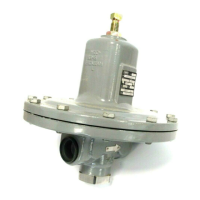MR95 Series
14
Replacement or Maintenance of Orice
and Valve Plug
If it appears that the valve does not shut off tightly, the
orice and valve plug could be worn out or damaged.
Proceed as follows to check and/or replace them.
1. Shut down the regulator. Refer to “Shutdown”
section for the proper procedure.
2. Unscrew the valve plug guide (key 5) from the
body (key 1). The valve plug spring (key 26) and
the valve plug (key 4) will normally come out of the
body along with the valve plug guide. On 1-1/2 or
2 in. / DN 40 or 50 body size regulators, the stem
(key 6) will also come out of the regulator body.
3. Inspect the seating surface of the valve plug (key 4),
make sure that the elastomer, PTFE or polished
metal surface of the valve plug is not damaged. Also
inspect the external O-ring (key 4c) on the valve
plug of Type MR95HP. Replace the valve plug
assembly if damage is noted.
4. Inspect the seating edge of the orice (key 3).
If damage is noted, unscrew the orice from
the body (key 1) and replace it with a new part.
Reference Table 8 for proper torque values.
5. Reassemble the regulator in the reverse order of
the above steps. When installing the valve plug
guide (key 5), coat the threads and sealing surface
with sealant to ensure an adequate metal-to-metal
seal. Reference Table 8 for proper torque values.
Flange Cap Screw Torque Inspection
Retorquing of spring case cap screws may be
necessary for some MR95 Series regulators after a
period of use. Retorque the cap screws as follows:
1. Shut down the regulator. Refer to Shutdown
section for the proper procedure.
2. Retighten the cap screws (key 16) in a crisscross
pattern. See Table 8 for proper torque values.
3. Follow the Startup section to repressurize
the regulator.
4. Refer to the Replacement of Diaphragm section
as needed.
Replacement of Diaphragm
When the regulator does not respond to differential or
downstream pressure changes, if uid leaks or vents
to the spring case (pressure reducing regulators) or
the loading pressure seems to leak to the downstream
piping (differential pressure regulators), the diaphragm
could be worn out or ruptured. Inspect/replace the
diaphragm as follows:
CAUTION
Metal diaphragms have thin sharp
edges. To avoid hand cuts, be careful
when handling the diaphragm and
particularly the diaphragm edge.
1. Shut down the regulator. Refer to “Shutdown”
section for the proper procedure.
2. For Types MR95L, MR95H, MR95HP and
MR95HT—loosen the jam nut (key 17) and turn
the adjusting screw (key 15) counterclockwise to
remove all spring compression.
For Types MR95LD and MR95HD—turn the
handwheel (key 38) counterclockwise to remove
all spring compression.
CAUTION
Provide adequate support to the spring
case when disassembling MR95 Series
regulator installed in a vertical
installation or other application where
the spring case is not oriented upward.
Without adequate support, the spring
case may fall and cause physical injury
when the cap screws are loosened.
3. Remove the cap screws (key 16) from the
diaphragm casing. Lift the entire spring case
(key 2) off of the body (key 1).
4. Remove the upper spring seat (key 9) and
regulator spring (key 11). For Types MR95H,
MR95HP and MR95HT with body sizes 1-1/2 and
2 in. / DN 40 and 50 skip steps 5 and 6.
5. For Type MR95HD and 1/4 NPT to 1 in. /
DN 25 body sizes of Types MR95H, MR95HP
and MR95HT—remove the lower spring seat (key 8).
For Types MR95L and MR95LD—remove the
diaphragm head assembly (key 21, lower spring
seat and diaphragm head threaded together).
6. Remove the diaphragm(s) (key 12) and examine
for damage. Replace if damage is noted. See
Table 7 for the required number of diaphragm(s).
Proceed to step 9.
7. For body sizes 1-1/2 and 2 in. / DN 40 and 50,
remove the diaphragm and diaphragm head. The
diaphragm head can only be disassembled for the
1-1/2 and 2 in. / DN 40 and 50 sizes. Disassemble

